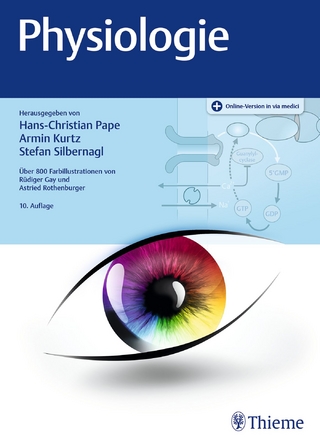
Lippincott® Illustrated Reviews: Physiology
Lippincott Williams and Wilkins (Verlag)
978-1-4963-8582-6 (ISBN)
- Titel erscheint in neuer Auflage
- Artikel merken
Enhanced by a new chapter, new illustrations, and new Q&As, Lippincott ® Illustrated Reviews: Physiology, Second Edition brings physiology clearly into focus, telling the story of who we are; how we live; and, ultimately, how we die. By first identifying organ function and then showing how cells and tissues are designed to fulfill that function, this resource decodes physiology like no other text or review book. Tailored for ease of use and fast content absorption, the book’s outline format, visionary artwork, clinical applications, and unit review questions help students master the most essential concepts in physiology, making it perfect for classroom learning and test and boards preparation.
A new chapter on erythropoiesis and blood gas transport provides critical information on this key topic.
New content on the impact of normal aging on organ function brings the book thoroughly up to date.
Review questions with explanations for each system help prepare students for course and board examinations.
More than 600 annotated, full-color illustrations—including more than 20 new to this edition—guide readers step by step through complex processes.
Overviews and Chapter Summaries set clear goals for topic mastery and reemphasize essential concepts in a coherent framework.
Clinical Applications boxes and clinical images encourage readers to apply their knowledge, taking them from the classroom to the bedside.
Margin Example Equation boxes and in-text boxes highlight memorable information and keep physiology in a real-world context.
Five online animations explain complex concepts in a memorable way.
A consistent outline format makes critical information easy to access and assimilate.
Cross references and Infolinks to topics are keyed to page headers to expedite location and are also provided for topics in other books in the Lippincott ® Illustrated Reviews series to help students develop an interdisciplinary grasp of key concepts.
Unit-review questions in board-review style test understanding of fundamental concepts as well as the students’ ability to draw connections among multiple organ systems.
eBook available for purchase. Fast, smart, and convenient, today’s eBooks can transform learning. These interactive, fully searchable tools offer 24/7 access on multiple devices, the ability to highlight and share notes, and more
Contents
Abbreviations, x
UNIT I: Principles of Physiologic Function
Chapter 1: Cell and Membrane Physiology, 1
Chapter 2: Membrane Excitability, 16
Chapter 3: Osmosis and Body Fluids, 27
Chapter 4: Epithelial and Connective Tissue, 36
UNIT II: Sensory and Motor Systems
Chapter 5: Nervous System Organization, 53
Chapter 6: Central Nervous System, 66
Chapter 7: Autonomic Nervous System, 77
Chapter 8: Vision, 91
Chapter 9: Hearing and Balance, 102
Chapter 10: Taste and Smell, 114
Chapter 11: Motor Control Systems, 122
UNIT III: Musculoskeletal and Integumental Physiology
Chapter 12: Skeletal Muscle, 137
Chapter 13: Smooth Muscle, 149
Chapter 14: Bone, 158
Chapter 15: Skin, 169
UNIT IV: Cardiovascular System
Chapter 16: Cardiac Excitation, 183
Chapter 17: Cardiac Mechanics, 200
Chapter 18: Blood and the Vasculature, 215
Chapter 19: Cardiovascular Regulation, 233
Chapter 20: Special Circulations, 252
UNIT V: Respiratory System
Chapter 21: Lung Mechanics, 265
Chapter 22: Gas Exchange, 283
Chapter 23: Blood and Gas Transport, 294
Chapter 24: Respiratory Regulation, 308
UNIT VI: Urinary System
Chapter 25: Filtration and Micturition, 323
Chapter 26: Reabsorption and Secretion, 339
Chapter 27: Urine Formation, 352
Chapter 28: Water and Electrolyte Balance, 368
UNIT VII: Gastrointestinal System
Chapter 29: Principles and Signaling, 389
Chapter 30: Mouth, Esophagus, and Stomach, 395
Chapter 31: Small and Large Intestines, 404
Chapter 32: Exocrine Pancreas and Liver, 414
UNIT VIII: Endocrine System
Chapter 33: Endocrine Pancreas and Liver, 423
Chapter 34: Adrenal Glands, 434
Chapter 35: Thyroid and Parathyroid Glands, 443
Chapter 36: Male and Female Gonads, 452
UNIT IX: Living and Dying
Chapter 37: Pregnancy and Birth, 467
Chapter 38: Thermal Stress and Fever, 480
Chapter 39: Exercise and Bed Rest, 488
Chapter 40: Systems Failure, 498
APPENDICES
Appendix A: Normal Physiologic Values, 521
Appendix B: Reference Equations, 524
Figure Credits, 525
Index, 529
| Reihe/Serie | Lippincott Illustrated Reviews Series |
|---|---|
| Verlagsort | Philadelphia |
| Sprache | englisch |
| Maße | 213 x 276 mm |
| Gewicht | 1361 g |
| Themenwelt | Studium ► 1. Studienabschnitt (Vorklinik) ► Physiologie |
| ISBN-10 | 1-4963-8582-9 / 1496385829 |
| ISBN-13 | 978-1-4963-8582-6 / 9781496385826 |
| Zustand | Neuware |
| Informationen gemäß Produktsicherheitsverordnung (GPSR) | |
| Haben Sie eine Frage zum Produkt? |
aus dem Bereich



